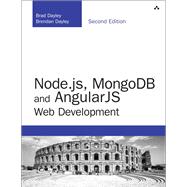Node.js, MongoDB and Angular Web Development
The definitive guide to using the MEAN stack to build web applications
Node.js is a leading server-side programming environment, MongoDB is the most popular NoSQL database, and Angular is the leading framework for MVC-based front-end development. Together, they provide an easy-to-implement, fully integrated web development stack that allows web programmers to create high-performance sites and applications built completely in JavaScript, from server to client.
Updated for Angular 2, Angular 4, and subsequent versions, this new edition of Node.js, MongoDB and Angular Web Development shows you how to integrate these three technologies into complete working solutions. It begins with concise, crystal-clear tutorials on each technology and then quickly moves on to building common web applications.
You’ll learn how to use Node.js and MongoDB to build more scalable, high-performance sites, how to leverage Angular’s innovative MVC approach to structure more effective pages and applications, and how to use all three together to deliver outstanding next-generation Web solutions.
- Implement a highly scalable and dynamic web server using Node.js and Express
- Implement a MongoDB data store for your web applications
- Access and interact with MongoDB from Node.js JavaScript code
- Learn the basics of TypeScript
- Define custom Angular directives that extend the HTML language
- Build server-side web services in JavaScript
- Implement client-side services that can interact with the Node.js web server
- Build dynamic browser views that provide rich user interaction
- Add authenticated user accounts and nested comment components to your web applications and pages
Part I: Getting Started
1 Introducing the Node.js-to-Angular Stack
2 JavaScript Primer
Part II: Learning Node.js
3 Getting Started with Node.js
4 Using Events, Listeners, Timers, and Callbacks in Node.js
5 Handling Data I/O in Node.js
6 Accessing the File System from Node.js
7 Implementing HTTP Services in Node.js
8 Implementing Socket Services in Node.js
9 Scaling Applications Using Multiple Processors in Node.js
10 Using Additional Node.js Modules
Part III: Learning MongoDB
11 Understanding NoSQL and MongoDB
12 Getting Started with MongoDB
13 Getting Started with MongoDB and Node.js
14 Manipulating MongoDB Documents from Node.js
15 Accessing MongoDB from Node.js
16 Using Mongoose for Structured Schema and Validation
17 Advanced MongoDB Concepts
Part IV: Using Express to Make Life Easier
18 Implementing Express in Node.js
19 Implementing Express Middleware
Part V: Learning Angular
20 Jumping into TypeScript
21 Getting Started with Angular
22 Angular Components
23 Expressions
24 Data Binding
25 Built-in Directives
Part VI: Advanced Angular
26 Custom Directives
27 Events and Change Detection
28 Implementing Angular Services in Web Applications
29 Creating Your Own Custom Angular Services
30 Having Fun with Angular








